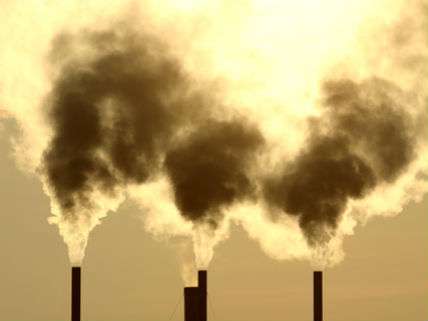Climate Policy Actually Slowed Decarbonization Trends
Paris climate agreement will reduce global warming by 0.2 degrees Celsius by 2100

Forty rich countries agreed in the Kyoto Protocol to cut by 2012 their future greenhouse gas emissions by around 5 percent below what they were emitting in 1990. The United States, which never ratified the Kyoto Protocol, would have been required to cut its emissions by 7.2 percent below their 1990 levels. A new study, "Does Climate Policy Matter?," by the folks at the eco-modernist Breakthrough Institute looks how greenhouse gas trends fared before and after the treaty was negotiated. The Breakthrough analysts point out that the downward trend in carbon intensity (that is the amount of carbon dioxide emitted to produce a unit of GDP) and upward trend in generating low-carbon energy for signatory countries actually slowed once the Kyoto Protocol was finalized in 1997. From the analysis:
Overall, the carbon intensity of economies that were party to the Kyoto Accord fell more rapidly in the decade before the agreement was signed than in the decade after. In the 10 years before signing, the compound annual growth rate for carbon intensity was -0.7%. In the 10 years after signing it was only -0.2%. Similarly, the low-carbon share of energy was growing at an annual rate of 1.0% in the ten years prior to 1997, and only at a rate of 0.3% annually for the ten years after, meaning deployment of clean energy stalled or slowed in comparison to fossil fuels in these countries after they signed Kyoto.
Interestingly, the Breakthrough analysts conclude that U.S. carbon dioxide emissions have actually fallen faster since 2010 than they would have had the the Waxman-Markey cap-and-trade scheme been adopted by Congress. The U.S. trend toward lower carbon dioxide emissions was helped along by the global financial crisis, a weak recovery, and the ongoing switch from coal to cheap natural gas for electricity generation.
Despite Germany's much-vaunted Energiewende, the Breakthrough report notes, "Germany's share of clean energy grew at 2% annually before 2007 and only 1% annually after 2007, and the carbon intensity declined at 0.5% annually before 2007 but has been almost flat since then."
So will the Paris Agreement on climate change make a difference? The Breakthrough report cites a 2015 MIT climate modeling study that estimated the effect that the Paris commitments would have on climate in 2100. The Breakthrough report observes that the MIT study …
… projects global atmospheric concentrations of carbon in 2100 at 710 ppm assuming full implementation of INDCs, versus 750 ppm in the absence of them, which translates to a difference in temperature increase above pre-industrial levels of 3.7 versus 3.9 degrees Celsius.
What becomes clear in looking at climate policy as it has been implemented at the international level is that most countries have only been willing to commit to decarbonization targets that are consistent with expected business-as-usual trends, accounting for measures that they have intended to take in any event.
So is international climate policy just "full sound and fury signifying nothing?" The Breakthrough report concludes:
Even should the next [U.S.] administration withdraw from the Paris Agreement and abandon the Clean Power Plan, the United States might outperform the commitments that the Obama administration made in Paris if it keeps the nation's nuclear fleet online, continues tax incentives for deployment of wind and solar energy, and stays out of the way of the shale revolution. By contrast, a Democratic administration indifferent to the fate of the nation's existing nuclear fleet and hostile to shale gas production might ultimately slow US decarbonization trends.
For folks worried about climate change, one big helpful de-regulatory step that could be taken by the new administration would be not just to keep existing nuclear power plants online but to revise the mission of the Nuclear Regulatory Commission to encourage innovators to develop and deploy safer and cheaper advanced nuclear power plants.


Show Comments (50)